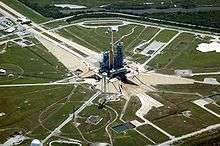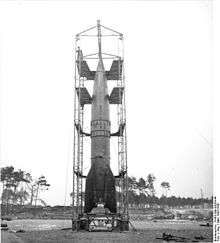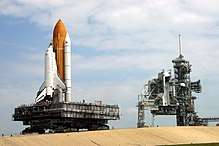Launch pad


A launch pad is an above-ground platform from which a rocket-powered missile or space vehicle is vertically launched. A spaceport (or launch complex) is a facility which includes, and provides required support for, one or more launch pads, although the term launch pad is often also used to describe the larger facility. A launch pad typically includes a launch mount or launch platform to support the vehicle and a service structure with umbilicals to provide propellants, cryogenic fluids, electrical power, communications and telemetry prior to launch. The service structure may also provide one or more access platforms to inspect and maintain the vehicle and to allow access to the crew cabin for vehicles carrying humans. The pad may contain a flame deflection structure to prevent the intense heat of the rocket exhaust from damaging the vehicle or pad structures, and a sound suppression system spraying large quantities of water may be employed. The pad may also be protected by lightning arresters.
A launch pad is distinct from a missile launch facility (or missile silo or missile complex), which also launches a missile vertically but is located underground in order to help harden it against enemy attack, or conceal it from surveillance.
Cryogenic propellants (liquid oxygen oxidizer, and liquid hydrogen or liquid methane fuel) need to be continuously topped off (i.e., boil-off replaced) during the launch sequence (countdown), as the vehicle awaits liftoff. This becomes particularly important as complex sequences may be interrupted by planned or unplanned holds to fix problems.
Most rockets need stable support for a few seconds after ignition while the engines build up to stable, full thrust. Therefore, the vehicle is commonly held on the pad by hold-down arms or explosive bolts, which are triggered when the vehicle is stable and ready to fly, at which point all umbilical connections with the pad are released.
Transport of rockets to the pad


.jpg)
There are several different types of launch site, determined by the means by which the space vehicle gets to the pad.
- The first large rocket, the V-2, travelled horizontally with its tail forward to the launch site on a transporter erector launcher which then raised it to the vertical position. This method was subsequently used for all large Soviet rockets, including the Soyuz, N1 and Energia, and is also used by SpaceX for its Falcon rockets.
- In a similar manner, at the Soviet launch site near Volgograd, a silo used to launch test rockets would have its top opened and a second stage and payload would be driven in horizontally and tilted on top of a first stage already in the silo, the nose cone and some of the second stage remaining visible above ground. Hence no surface pad is used; Russian silos are reusable. This method was only used for the Cosmos series of small satellite launching vehicles.
- A method of assembling a large space vehicle vertically in a Vehicle Assembly Building on a Mobile Launcher Platform (MLP), which contained the umbilical structure, was invented for the Apollo/Saturn V manned Moon landing vehicle. The MLP is then carried by a Crawler-transporter, which slowly drives to one of two pads at Launch Complex 39 at the Kennedy Space Center. This facility was later used for the smaller Apollo/Saturn IB, and then the Space Shuttle.[1] A similar system is used to launch Ariane 5 rockets at ELA-3 at Guiana Space Centre, a French spaceport near Kourou in French Guiana.
- The Titan III and Titan IV launch vehicles were transported with a mobile launcher platform on two parallel standard gauge railroad tracks from the integration building to launch areas at Cape Canaveral Air Force Station Space Launch Complex 40 and 41. This system is still in use for the Atlas V.
- At Vandenberg Air Force Base, in California, the Titan series of rockets were set up vertically in a gantry in a windowless building at SLC-4, the outside walls of which were rolled away just at launch. This was done for purposes of military secrecy. Similar systems are used at SLC-6 and LC37 at Cape Canaveral Air Force Station for the Delta IV rocket, ELA-1 & 2 at CSG for the Ariane 1-4, and Kagoshima for the M-V.
- In the 1920s, Hermann Oberth described a method in which the vehicle is assembled vertically on a floating barge, which he used in the movie Frau im Mond. This was seriously considered for use at Kennedy Space Center Launch Complex 39 for the Saturn V, but was rejected due to the instability of the top-heavy unfuelled rocket and gantry. However, the Sea Launch service uses the converted self-propelled oil drilling platform Ocean Odyssey to transport Zenit 3SL rockets horizontally to the Equator, and then to erect and launch them into geostationary transfer orbits.
- Dnepr rockets are transported vertically and then inserted into a silo, as they are converted cold-launch R-36 Voevoda ICBMs.
See also
References
Wikidata has the property:
|
- ↑ "LAUNCH COMPLEX 39, PADS A AND B". NASA KSC. 1992. Archived from the original on 2008-09-21.
